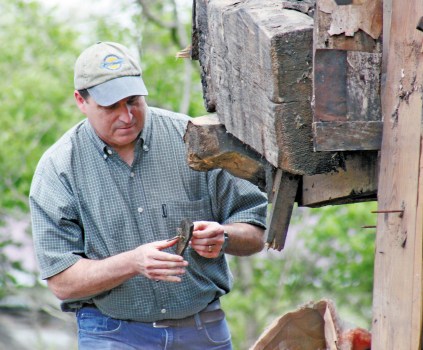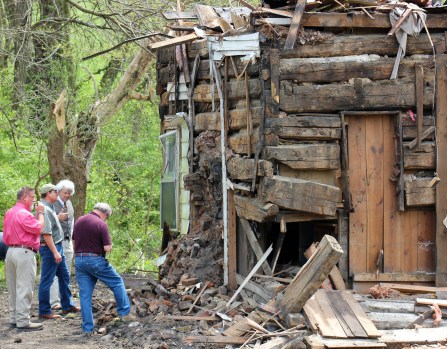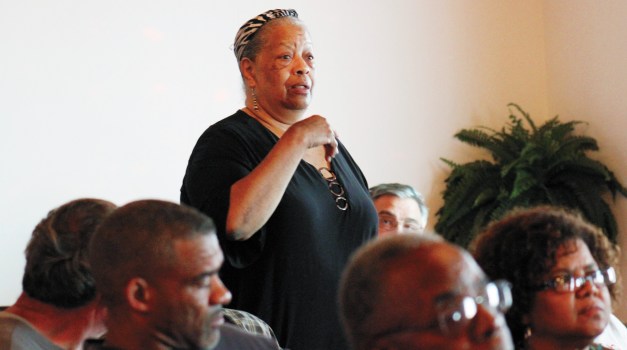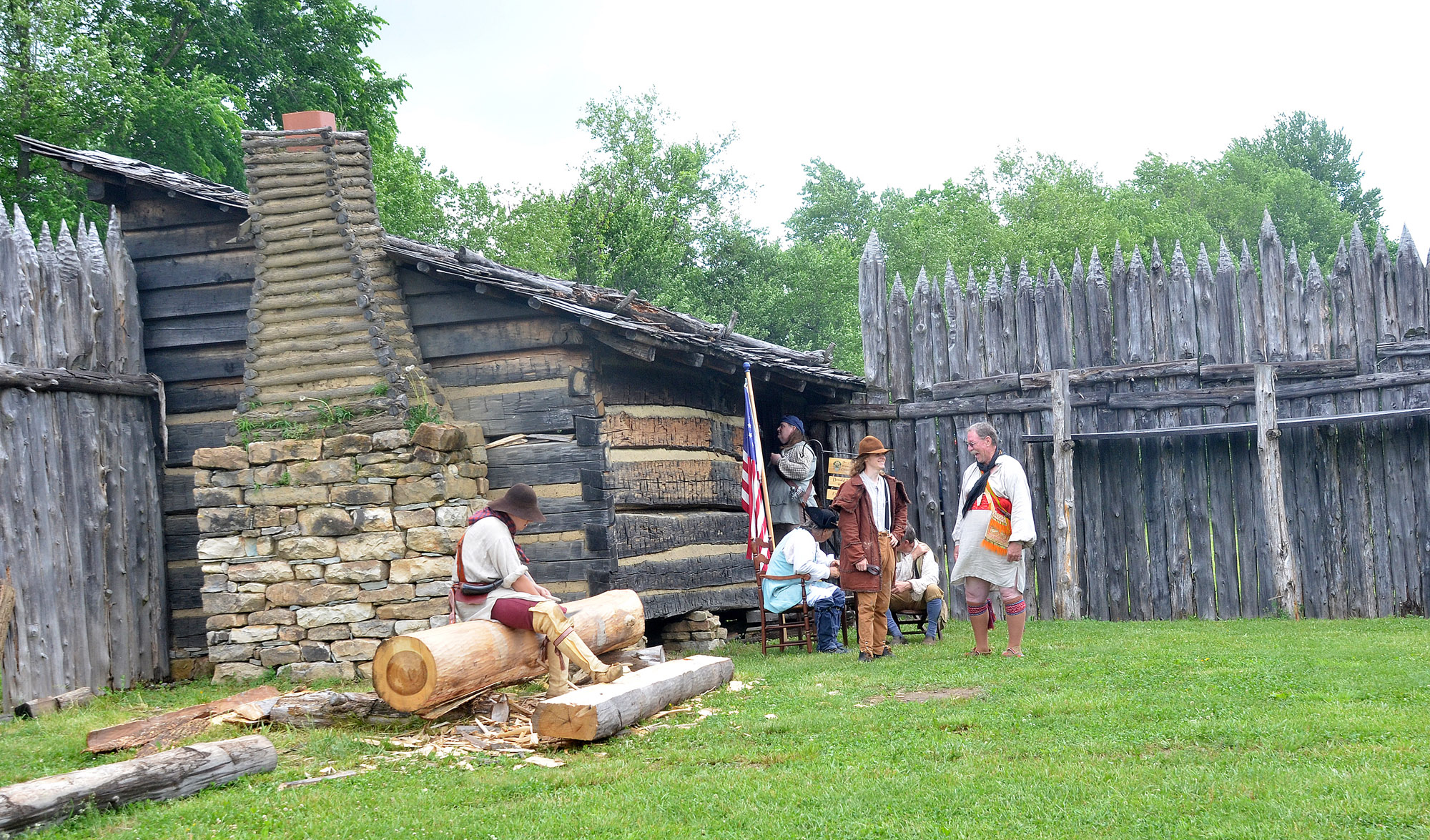Archaeologists inspect historical cabin in Stanford
Published 12:15 pm Thursday, April 25, 2019
Mayor, city attorney, code enforcement answer questions
STANFORD —Archaeologists from the University of Kentucky came to Stanford last week to inspect a cabin that was found during a city demolition – a cabin they said could date back to the mid-1800s.
Mayor Scottie Ernst, along with Dr. David Pollack and Dr. Jay Stottman, staff archaeologists with the Kentucky Archaeological Survey, addressed several media members outside the cabin after the inspection.
“I think what’s interesting about this cabin is that it was hiding inside of a house for so many years and nobody knew about it. That happens a lot with these kinds of buildings,” Stottman said. “In talking to our architectural historian, she believes that it’s probably a mid-19th century building, probably 1840s, in that area, just on a cursory look…”
Stottman said what he’s seen of the building seems to back up that time period as well.
“Based on some of the nails I’ve seen here, the brick used in the building, that gives me some clues as to what the age of the building might be,” he said.
The structure appeared to have been built on the property, Stottman said.
“Some of the chinking, that space in between the logs, you see different types of materials used there, stone and wood, and some mud plaster, things like that, it’s really interesting. A lot of times that stuff doesn’t get preserved very well,” he said. “It tells us a little about some of the people who might’ve lived here.”
The archaeologists said in order to compare the structure to others in the county, a complete survey of historical structures would need to be done.
“In terms of evaluating a building like this, in terms of it’s age, Lincoln County is one of the few counties that has not had a full, comprehensive survey of the county, so we can’t really say how many buildings of any particular time period or style stand,” Pollack said. “That’s one of the things the county really needs some time in the future, is to have a full, comprehensive survey…”
Stottman said historical buildings of every day people are rarely preserved.
As far as the possible connection to Logan’s Fort, Garlan Vanhook said while the time period suggested by archaeologists is well after the Siege of 1777, it’s a progression away from the original site of the Fort, as people moved closer to where Main Street is today.
“The Fort was founded on St. Asaph Creek, and as you can tell St. Asaph Creek goes right behind this so it would continue through here. That could also be an indicator that it was in proximity of the Fort and why they would have located this cabin here,” said Jane Vanhook, of the Lincoln County Historical Society.
Ernst said the cabin, which could be as old as 200 years, is part of the city’s history, regardless of whether it’s connected to Logan’s Fort.
The archaeologists commended the city and the demolition crews for stopping the demolition when the cabin was discovered.
“These buildings can tell a story,” Pollack said. “You can tell a story and learn about who lived there, how did their family evolve, how did they grow, how did they change the building.”
Pollack said they plan to send an architectural historian to look at the cabin and get more detail.
Local historian and Property Valuation Administrator David Gambrel said his initial research of property deeds indicates it was originally owned by William Logan, a descendant of Benjamin Logan, and was sold to David Shanks in 1812.
Community asks questions
After learning about the partial demolition and discovery of the log cabin, family members and friends of the late Emma Stewart, and other community members, had some questions and concerns about the city’s code enforcement process.
City Council member Sara Givens called a meeting at the Boneyville Baptist Church and invited the Mayor, Code Enforcement Officer and City Attorney to take questions about code enforcement and House Bill 422 (HB422), an ordinance adopted by the City Council in 2017.
Even prior to HB422 the city had the ability to act on structures that were deemed an “imminent danger” through the state fire marshall, according to City Attorney John Hackley.
“HB422 did codify, in a much firmer way, the way that the city can deal with a range of nuisances,” he said. Hackley said the law placed more authority in local officials’ hands when it comes to dealing with property issues.
Jeff Knouse has been Stanford’s Code Enforcement Officer since 2015, but following the City Council’s adoption of HB422, he went from part-time to a full-time position. A Code Enforcement Board was also formed as a result of the ordinance.
“To date, I have sent out over 600, closer to 700, violations, just in the city limits of Stanford,” Knouse said. “Those deal with dilapidated housing, tall grass, inoperative vehicles, trash (and) rubble, unsanitary conditions with leaking sewers and things like that. It’s not an easy job, but I’m the man that stands behind that violation when a citizen gets it.”
Monday night, Knouse explained the process and parts of the ordinance that led to the city’s demolition of the Hustonville Street house before answering questions.
Knouse said there are several factors that define a dilapidated house, including being open to the elements or having an unstable foundational issue.
Per the ordinance, Knouse said demolition orders that are not on a structure that has been deemed an imminent danger requires the Code Enforcement Officer to notify the owner of record and the owner has a stipulated amount of time to bring the house into compliance or tear it down.
“When in the opinion of the code enforcement officer that imminent danger exists on the subject property that necessitates immediate action, or there is reason to believe that the existence of violation in this chapter in respect to the structure presents a serious threat to the public health, safety and welfare or; that the structure is so old, dilapidated, has become so far out of repair, as to be dangerous, unsafe, unsanitary or otherwise unfit for human habitation or occupancy or; demolition is otherwise reasonably necessary to protect the public interest,” Knouse stated, reading from the ordinance.
“That’s a lot of the reasons behind this house,” he said.
According to Hackley, the structure had caught fire previously, which also calls for immediate action.
“It had caught on fire and I guess when the fire department was there they cut holes in the roof. When they do that, they do it for ventilation purposes,” Knouse said. “When you do that, it opens to the elements and the roof starts deteriorating.”
Knouse said if a house catches on fire and sustains damage, state law says the owner has 60 days to make the structure safe or remove it. He wasn’t positive when the fire occurred but said he believes it was in 2010.
The first question from the audience came from Brenda Coffer, who asked why property owners aren’t notified prior to demolition.
Demolition orders were served on the Hustonville Street property in Oct. 2017, Knouse said, before an imminent danger was declared. The owner of record, Ka’Sandra Brown, was notified, he said, and given 30 days to either bring the property up to code or demolish it.
Property Valuation Administrator David Gambrel spoke up at that point, noting that the tax bill is in Brown’s name but that does not make her the owner of the property.
“It’s Emma K. Stewart listed on the property card and then it’s got the percentage mark under that says ‘in care of Ka’Sandra Brown’ so that’s who I sent the paperwork to,” Knouse said.
Knouse said after a few violations were sent to Brown related to the tall grass, Brown came to speak with him.
While Brown was notified of the earlier demolition orders – no response was received from her according to the city – she was not notified about the recent demolition by the city.
“Imminent danger is you act, you don’t have time for that type of stuff,” Knouse said. “When an imminent danger exists like that, we don’t have to give the owner any notification. She had already been notified and stated to me that she couldn’t take care of the property before on other violations that went out. When buzzards are carrying dead animals and living in it, that’s unsanitary conditions. There were fire hazards and all kinds of stuff like that. That’s the reason I made that call.”
Gambrel said the property is “heir’s land” which means there is no legal document establishing the current owners of the property. In order for that to happen, one of the heirs would have to file an affidavit of descent that states Emma Stewart died without a will and lists the heirs.
“Ka’Sandra, is, from what I know and understand, she would be a one-eighth heir in this property,” Gambrel said.
Gambrel brought up the old property located directly across from 135 Hustonville Street, which he referred to as “Mrs. Young’s Store.” It was originally owned by George Gentry who served in the 4th U.S. Colored Calvary in the Civil War.
“I don’t want to meddle in the city’s business, but looking at that, I don’t know how you can say that’s not open to the elements,” he said. Gambrel said with it being an heir’s property as well, there is potential for the same situation to occur.
“This property (135 Hustonville Street) belongs to the estate of Emma Stewart and no one can settle that except her heirs,” he said.
Roland Cadle, part-owner of the company that’s building the replica of Logan’s Fort, asked what the city is asking the property owner to do now that the demolition has been halted and a historical discovery has been made.
Knouse said the next step in the process, per ordinance, is for him to take the $5,500 in liens that the City of Stanford has on the property to the Code Enforcement Board.
“They will determine whether they want to force the lien or wait, or whatever the process is,” he said. “But that’s strictly a Code Enforcement Board. If they make the motion to force the lien, then the city attorney would start the foreclosure process on the lien.”
The mayor spoke to the question on what the city plans to do with the cabin.
“I don’t think anyone knew there was a cabin there,” Ernst said. Some people in the audience disagreed, however. Brenda Cofer said she’s known since the 1990s that a cabin was underneath the exterior structure.
Ernst said the city had reached out but had not spoken directly with the family since the cabin was discovered.
Hackley added that the imminent danger that was presented by the entire structure has diminished now that only the small cabin structure remains.
“We can at least pause for the period of time it will take to determine the historical significance,” Hackley said.
Cadle said, in his opinion, there are some significant issues that were not addressed by the archaeologists that visited the cabin and he would argue that there is over a 50-percent chance that the structure is connected directly to Logan’s Fort.
“The land is in the ownership of the Benjamin Logan family in 1812, when it is sold. The origin of the logs is the questionable part. I can tell you, on all my expertise, and we do this all over, that the remnants of that cabin do not support a date as late as the Civil War, the size, the construction, the method…,” Cadle said. “What you are dealing with now is what are the possibilities that this building actually was a part of the (Logan’s) Fort. I can tell you that the chances of that are better than 50 percent.”
Cadle said the property would not have been listed on the first federal tax records in 1790 because it did not have windows.
“That said, 1790 is the first federal tax, called the Glass Tax, and you are taxed by the number of window panes that you had. That house had no windows, it’s not on the tax,” he said. “It’s a legitimate compelling argument to say, ‘this is not an 1840s cabin, neither is it an 1812 cabin, but because Logan owned the land until it was sold in 1812, that that cabin was one of the cabins in the Fort.’”
Gambrel clarified that he has not confirmed with certainty that it was owned by Benjamin Logan, but that is what his initial research indicates.
“We don’t know in absolute certainty that that was Benjamin Logan’s land. If that 1841 deed is correct, then it was Benjamin Logan’s but, the only way to do that is to go back with further research because in 1853, for the first time, it’s cut off as the acre-and-a-half tract that it is today,” he said.
The building was moved to the current site, in Cadle’s opinion, because there is no foundation in the dirt. Cadle said the ceiling and second floor haven’t been inspected yet and could give more insight. Dating the wood through testing is also a possibility, he said.
The property on Hustonville street is about a quarter-of-a-mile from Logan’s Fort, he added.
He suggested that the city, with the owners’ permission, have the building dismantled and take ownership of the viable parts in exchange for removing any existing liens against the property.
It could cost up to $35,000 to restore the cabin to it’s original state, Cadle said, and with some of the logs being rotten, it wouldn’t be exact. There are some pieces that are worth preserving, he added, which could be used for a historical display at Logan’s Fort.
Diane Miller asked if the City Council is involved in the decision making when addressing property issues or if there is a committee.
“The process is, when an imminent danger doesn’t exist, a violation goes out for 30 days, then a citation, and at that point, if nobody comes to us, then it becomes a final order. That’s when the Code Enforcement Board gets involved and they set that hearing date and that person can come in and plead their case with the code enforcement board,” Knouse said.
Miller, who described herself as a concerned citizen, said she knows Brown had contacted Miller’s brother to mow the grass and when he went to mow, the city had already mowed it.
“You all did not allow her those two weeks,” Miller said.
Knouse said there were several tall grass violations on the property and he can’t answer directly to that without having the records in front of him.
“Normally if a violation goes out, they have seven days. If they don’t comply or they don’t call us and work something out, a citation will go out. After seven days, they can appeal that,” he said. “After the eighth day, after the citation, then the city goes out and abates the nuisances.”
Phyllis Walker said she understands there is a right and a wrong way and, in her opinion, the way the city handled the situation was wrong.
Cofer said her personal dealings with code enforcement went differently than it did for the owners of the Hustonville Street property.
“You dealt with me differently,” she said. “…We worked together, back and forth, you gave me time, you gave me this, I had questions, you called me, I called you. We were on it.”
Cofer added that there are several structures in the city that are in worse shape and present more danger. George A. Miller agreed, pointing to another structure located near Logan’s Fort at the end of Martin Luther King Street, which he said is open to the elements and poses a danger to the public.
Knouse said a main difference is that Cofer responded and got in touch with him after she received notice. He added that code enforcement will look at the property mentioned by George Miller and that other structures will be dealt with but the timing is dependent on the code enforcement department’s budget.
Sara Givens said the city council was not aware of the demolition on Hustonville Street and it was strictly a code enforcement decision.
The mayor said the Hustonville Street structure is one of several that the city plans to remove as time and the budget permits.
“As it goes through the steps of the law, correctly, and the ordinances, there will be other houses demolished,” Ernst said.
Cofer suggested that the city publish a list of upcoming demolition projects in the newspaper to notify the community.
Miller pointed to the city’s handling of Tommy Owens’ property behind Walmart, which has been the subject of several City Council discussions in the last six months.
“You all look at that out there and you don’t think that’s an imminent danger? Are you all addressing that? Are we just looking at a different type of population in addressing that?” she said. “My concern is, if we’re going to do this, then let’s be fair across the board.”
Knouse said there is no structure on the Owens property.
“There is still 13, 14 houses. There are still inoperative vehicles that we’re working on. It takes time to get there, but eventually we will get all the way across the city,” he said.
City Council members Ronnie Deatherage and Peggy Hester, who both served on the council when the HB422 ordinance was adopted by the city, also attended Monday’s meeting with a few questions and comments.
Deatherage said with a limited budget, code enforcement has to choose which properties to address, with the most dangerous being priority.
“When we adopted HB422 it was to clean up our town and to try to get it so you’re happy with and we’re happy with it,” he said.
Hester added that she thinks the definition of “imminent danger” needs to be more clearly defined by the city.
“We cannot think that, at any time, that it’s OK to walk onto someone’s property, when all heirs have not been notified, and push over their house,” Hester said. “But notice it was done pretty carefully…the cabin was left standing. I think that it was known that there was a cabin there. I think there’s worth to that cabin…”
Hester said the city needs to move forward with code enforcement in a way that’s courteous to residents of the city.
“Not just to the $40 million-dollar people,” she said.
The mayor reiterated that the city was not aware that a cabin existed underneath the exterior structure of the house.
Jerry Wilkinson wrapped the discussion up by reminding the congregation that it’s up to the citizens to stay informed and stay involved.
“That’s why the country is in the shape it’s in now because some just decided they were going to sit it out,” he said. “We’ve got to know the rules.”










